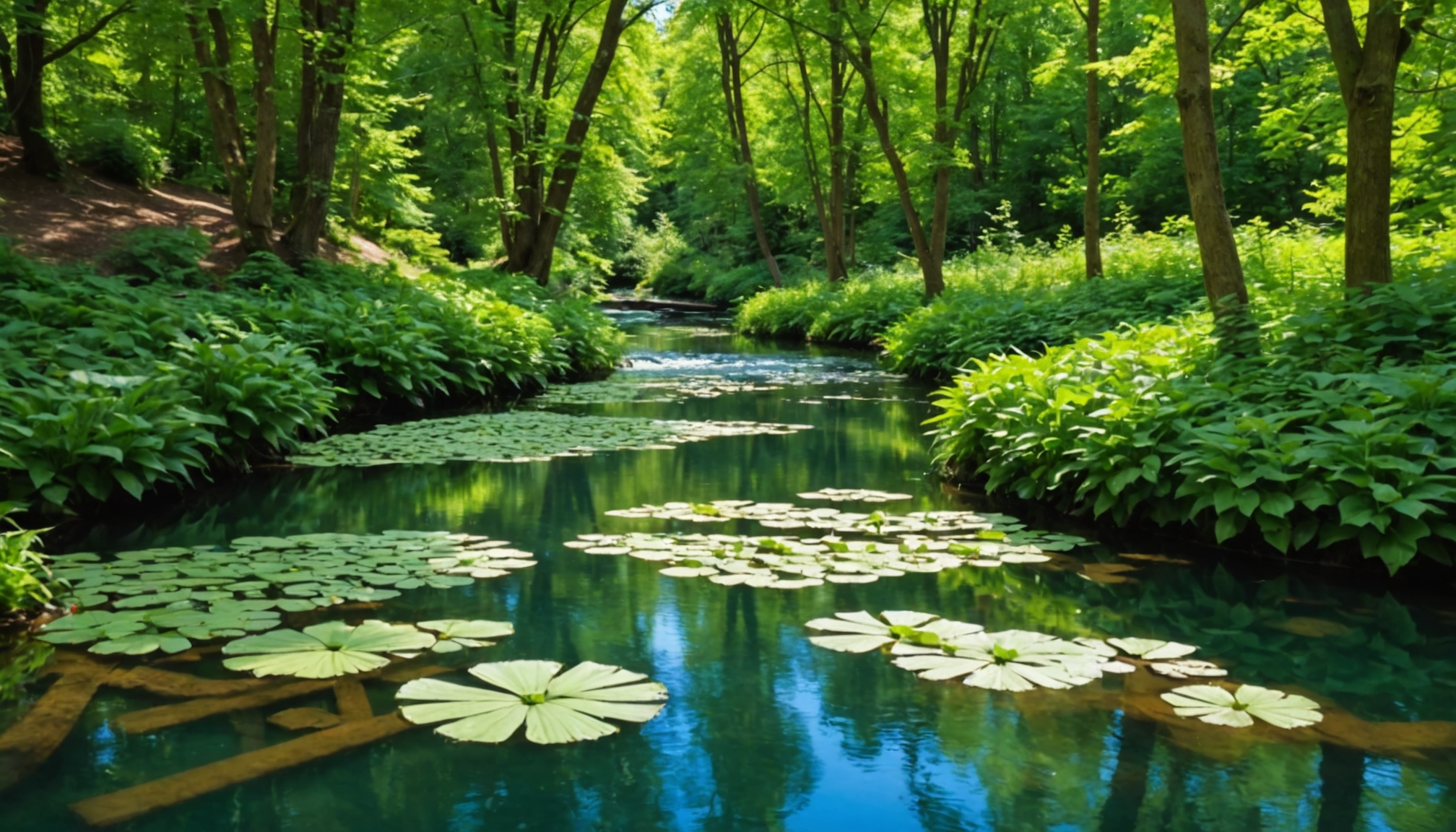Water has long been associated with tranquility and peace, making it an ideal element for spaces designed to promote relaxation. The calming effects of water features are not just aesthetic; they also offer sensory experiences that engage the mind and soothe the soul. Whether it’s the gentle babble of a stream, the rhythmic splash of a fountain, or the stillness of a reflective pond, water features can transform outdoor environments into sanctuaries of calm.
The sound of flowing water has a profound impact on the human psyche. It naturally masks unwanted noises such as traffic or loud neighbors, creating an acoustic shield that enhances the serenity of your backyard. This auditory buffer has been shown to lower stress levels, reduce anxiety, and even improve mood. The continual, patterned sounds of water encourage the mind to enter a meditative state, promoting focus and clarity.
Visually, water features add movement and life to an outdoor space. The reflective surfaces of ponds or small water gardens enhance the perception of space, making a garden feel larger and more expansive. These reflections can change throughout the day, adding a dynamic quality that keeps the environment interesting and engaging. As the light changes, the shimmering water can create captivating light displays that enhance the aesthetic appeal of the garden.
The cooling effects of water are another significant benefit. During hot weather, water features can help moderate the temperature of an area, making patios and gardens more usable and enjoyable. The evaporation from water sources can produce a mild cooling effect, providing relief on sweltering days.
A variety of water features can be incorporated to harness these calming effects, and each type has unique characteristics:
| Type of Water Feature | Auditory Impact | Visual Appeal | Ideal for |
| Fountain | High – Dynamic sound of cascading water | Medium – Decorative, often a focal point | Urban gardens, small spaces |
| Pond | Low – Gentle, subtle ripples | High – Reflective and serene | Wildlife-friendly gardens, larger areas |
| Stream | Moderate – Natural, soft babble | Medium – Mimics natural landscapes | Naturalistic gardens, sloped terrains |
| Waterfall | Very High – Powerful rushing sound | High – Dramatic and eye-catching | Rock gardens, statement pieces |
Incorporating a water feature into your backyard not only enhances its aesthetic appeal but also fosters a healthier psychological environment. As life becomes increasingly fast-paced and stress levels rise, the presence of water features in a garden offers an accessible retreat for relaxation and rejuvenation. Whether choosing a small patio fountain or a sprawling backyard pond, water features bring a touch of nature’s serene power to any space, enriching both the habitat and those who reside within it.
choosing the right design for your space
When selecting the perfect water feature, it’s essential to consider the characteristics and constraints of your specific outdoor area. Here’s a step-by-step guide:
- Measure Your Space: Begin by assessing the dimensions of your outdoor area to understand the scale of the feature you can accommodate. A smaller backyard may benefit from a compact fountain, while a larger garden can support an expansive pond or stream.
- Determine the Purpose: Consider how you want to use the space around the water feature. Is it intended to be a focal point for relaxation, a backdrop for social gatherings, or a habitat for wildlife? Your primary intent will influence the style and scale of the feature you select.
- Analyze Sun and Shade Patterns: Observe how natural light interacts with different areas of your garden throughout the day. Some water features, like ponds, may need partial shade to prevent excessive algae growth, while fountains or waterfalls often look stunning in well-lit areas where they can catch and reflect sunlight.
- Consider Your Style Preferences: Your aesthetic taste is crucial in choosing a design that complements your home and garden. Whether you prefer a sleek, modern fountain or a rustic, natural stone waterfall, ensure the water feature aligns with your overall outdoor theme.
- Evaluate Accessibility: Consider practical aspects such as proximity to a power source if you’re installing a feature that requires electricity for pumps. Ensure there’s ample space for necessary maintenance and that the feature is easily accessible yet safely integrated into its surroundings.
- Plan for Climate Conditions: Understand the climate in your area and choose water features that can withstand seasonal changes. For example, features made of durable materials or designed to be winterized will fare better in regions with harsh winters.
- Set a Budget: Finally, align your aspirations with a realistic budget. Remember to factor in not just the initial cost of the feature itself, but also installation expenses, ongoing maintenance, and potential utility bills associated with running a pump or filtration system.
By thoughtfully considering these aspects, you’ll be well-equipped to select a water feature that harmonizes with your garden, enhances your lifestyle, and creates a serene retreat in your own backyard.
incorporating natural elements
Incorporating natural elements into your backyard water feature not only enhances the aesthetic appeal but also creates a more harmonious and eco-friendly environment. Integrating stones, plants, and other organic materials can transform an ordinary water feature into a stunning visual masterpiece that mimics nature, offering a sanctuary of relaxation right in your backyard.
Firstly, consider using natural stone or rock formations around your water feature. These materials can be used to line ponds, edge fountains, or construct waterfalls, providing both structural support and a rustic appearance. Stones have a timeless quality and come in a variety of textures and colors, allowing you to tailor the look to fit seamlessly with your garden’s overall theme. Irregularly shaped stones can create a more genuine, untreated look, closely resembling natural bodies of water found in the wild.
Incorporating aquatic and marginal plants can further enhance the organic feel of your feature. Plants such as water lilies, lotus, and papyrus look stunning in ponds, providing cover and habitat for fish, while helping to oxygenate the water. Marginal plants like rushes, cattails, and irises planted around the edges of water features can soften the transition between water and land, offering a naturally elegant appearance. These plants not only bring life and movement but are also crucial for maintaining an ecological balance by supporting local wildlife like birds and beneficial insects.
Adding wildlife-friendly elements is another way to foster a natural setting. Consider designing your water feature to include a shallow area that gradually deepens, allowing for a diversity of habitats within the same body of water. Thinking about the needs of local wildlife can attract a variety of species, turning your backyard into a thriving ecosystem. Birds, amphibians like frogs and newts, and even small mammals can benefit greatly from a well-thought-out water feature.
Utilizing driftwood or logs strategically placed in or around the water feature provides a natural and aged aesthetic while offering resting or perching spots for wildlife. These elements add an artistic component and introduce various textures that can make the water feature more visually engaging.
Finally, consider the use of natural water-scaping techniques. Allow water plants to grow naturally to some extent, employing a more laissez-faire approach. This way, the water feature will evolve over time and can remain healthy and sustainable. The dynamic growth and change can make the landscape feel more alive and engaging, offering something new to observe with each season.
By embracing natural elements in your water feature design, you create a space that reflects the beauty of the natural world. These elements help embed the water feature into the landscape organically, rather than having it appear as a detached, artificial installation. The result is a tranquil and inviting space where you can unwind and reconnect with nature, surrounded by the sights and sounds that have soothed and inspired humans for centuries.
maintenance tips for longevity
To ensure the longevity of your backyard water feature, it is crucial to establish a routine maintenance schedule. Begin with regular inspections to check for physical damage, such as cracks or leaks in the structure. Over time, wear and tear can affect the feature’s integrity, but early detection can prevent more serious issues.
Addressing water quality is also vital. Regularly test the water to maintain the correct pH and balance, preventing algae overgrowth which can detract from the water feature’s aesthetic and health. Using water treatments like those containing beneficial bacteria can keep the water clear and healthy. Adding a quality filtration system will help keep debris at bay and maintain proper water circulation.
Cleaning is another essential maintenance step. Remove leaves, twigs, or any material that might accumulate in the water or around the feature. Doing this bi-weekly or more often during the fall ensures that debris doesn’t decay in the water, which can lead to unpleasant odors and attract pests.
Pumps and equipment, such as filters and heaters, should be inspected regularly to ensure they are operating efficiently. Clean or replace filters on a routine basis as clogged filters can drastically reduce water quality and circulation. Pumps should be checked for clogs and serviced according to the manufacturer’s instructions to avoid breakdowns.
Winterizing the water feature is crucial in climates with freezing temperatures. Drain the water and either remove pumps or store them in a protected, heated space. Covering the feature will shield it from freezing and thawing cycles that might cause damage. Use appropriate covers to protect the surface from snow and ice.
For features incorporating plants, trimming and pruning are necessary to prevent overgrowth that could impede water flow or overshadow the feature, leading to unbalanced ecosystems. In winter, remove any non-hardy plants indoors and mulch around perennials to protect them from the cold.
Adopting ecologically friendly practices can also aid longevity. Promoting a habitat for beneficial wildlife—such as fish that eat algae or snails that naturally clean surfaces—can reduce the maintenance burden by keeping the ecosystem in balance.
By embedding these practices into your maintenance routine, you can enjoy the serenity and beauty of your backyard water feature for many years to come. Staying attentive to these elements will not only preserve the feature’s appearance but also ensure it remains a tranquil centerpiece of your garden oasis.
integrating lighting for ambiance
Integrating lighting into your backyard water feature can dramatically enhance its ambiance, transforming it from a simple outdoor element into a captivating nighttime attraction. Thoughtfully placed lights can highlight the cascading flow of a waterfall or the gentle ripples of a pond, creating a magical and inviting atmosphere for evening relaxation.
When selecting lighting for your water feature, consider using submersible LED lights, which are both energy-efficient and versatile. These can be strategically placed to illuminate underwater plants, cast colorful glows along the water surface, or discreetly nestle beneath waterfalls to highlight cascading streams. The color-changing capabilities of many modern LED systems allow you to adjust the mood, offering a soothing blue for calm evenings or vibrant hues for social gatherings.
Solar-powered lights are an eco-friendly choice as they eliminate the need for wiring and operate automatically, recharging during the day to provide cost-effective illumination by night. Positioning solar lights around the perimeter of your water feature can beautifully highlight the surrounding landscape and create a harmonious blend of light and shadow.
Pathway lights can guide the way to your water feature while spotlighting the surrounding flora, adding depth and dimension to your garden. Functional and decorative, these lights enhance safety and accessibility, making the area welcoming and secure after sunset.
Consider incorporating floating lights for ponds or reflective pools. These lights drift gently along the water’s surface, creating an ever-changing light pattern that mirrors the tranquility of the night sky. Their subtle glow can transform a dull pond into a serene, glowing oasis.
For a dramatic touch, think about incorporating fiber optic lights. These can be threaded through waterfalls or edges of streams to mimic the glint of moonlight on flowing water. The gentle twinkle created by these threads of light can make your water feature resemble a starlit stream, offering an enthralling visual experience.
Effectively balancing light can make all the difference. Aim to use lighting to complement rather than overpower, enhancing the natural beauty of the feature and the garden’s overall aesthetic. Opt for warm-toned lights to evoke a cozy and intimate feel, which pairs well with evening leisure.
Incorporating lighting into your water feature not only increases its functionality by extending the hours of enjoyment but also adds a layer of beauty that enhances your outdoor space. Thoughtfully considered illumination can transform your backyard from daytime mellow to nighttime magic, making it a perfect sanctuary for relaxation regardless of the hour.
In conclusion, backyard water features offer a remarkable way to create a serene and inviting atmosphere in your outdoor space. Whether you opt for the soothing sound of a gently flowing stream or the visual allure of a glistening pond, water features can transform your garden into a private retreat. By carefully selecting designs that suit your space, integrating natural elements, ensuring proper maintenance, and adding thoughtful lighting, you create a sustainable and aesthetically pleasing environment that promotes relaxation and enhances the enjoyment of your outdoor living area.


